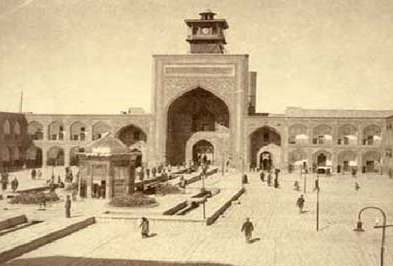Old photos and history of Imam Reza shrine
With the martyrdom of Imam Reza (AS) in the year 203, his pure body was buried next to the grave of Harun Al-Rashid. This emirate was located in the middle of a large and beautiful garden that belonged to Hamid bin Qahtaba, the governor of Tus. It is said that when Imam Reza (AS) went to Merv On the way, they landed at the house of Hamid bin Qahtaba and marked their burial place.
According to this article, the first building of the tomb was Harun al-Rashid's mausoleum, which was built by Mamun Abbasi, and the rest of the shrine was built on it. Sabkatkin (387-366 AH), the fanatical Ghaznavid king, destroyed the Holy Shrine and prohibited its pilgrimage, after that Amid al-Dawlah Fayq tried to complete the mausoleum and develop Mashhad.
In the year 400 AH, Abu Bakr Shahmard rebuilt the mausoleum once again by the order of Sultan Mahmud of Ghaznavi. According to the inscription on the tomb of Imam Reza (AS), it seems that the building of the shrine was renewed or repaired in the year 516 AH. The mausoleum building was heavily damaged in 548 AH.
During the Seljuk period, Sharaf al-Din Abu Taher Qomi, after restoring the building, built a tiled dome on the dome of the shrine and built a minaret next to it. The shrine is available.
During the time of Genghis, the mausoleum was destroyed. During the time of Ghazan Khan and then Sultan Mohammad Khodabande Al-Jayto, he tried to repair and decorate the Holy Shrine. In the 8th century, the building of the Haram consisted of: the Haram, the Balasar Mosque and several small buildings connected to the northern side and a school (according to Ibn Battuta, the famous traveler). During the time of Shahrukh Timuri and his wife Goharshad, the sacred shrine developed significantly.
During this period in 821 AH, the first comprehensive mosque of Mashhad city named Goharshad Mosque was built on the Qibla side of the Holy Haram, then the building of "Dar al-Hafaz", "Farq al-Dhakar Mosque", "Dar al-Siadeh" and "Delivering the House or Treasury" were built.
Around the complex, three schools named Parizad School, Balaser School, and Dodarb School were built during the time of Sultan Hossein Bayqra (912-875) due to the efforts of Amir Ali Shir Nawai, the Old Court and the base of the Golden Gate, the Revolution Hall was created during the time of Shah Abbas I. It expanded during the Safavid era of Shah Tahmasab, the minaret near the dome was restored and gilded, and in 932 AH, the exquisite clay tiles on the dome were turned into gold clays. He ordered that its description be engraved in the enameled inscription around the dome in the handwriting of Alireza Abbasi. - During the time of Shah Abbas, the old court (revolution) was expanded and the northern porch of the rooms, pavilions and entrances, and the eastern and western porches were built.
Manorah Roza, where the holy body of Hazrat Reza (AS) is buried, is located under a golden and magnificent dome and is considered the central core of the buildings of Astan Quds Razavi. In the early years, after the burial of the holy body of Imam (a.s.), the holy shrine was built in a simple structure with the special materials of that time, such that the holy shrine had only one simple entrance door in front of the blessed one and had brief decorations in its style. it was time The rows of the sides of the shrine, except for the front row, were closed to the outside of the building.
There was only one dome above the mausoleum. In those distant years, the lands around the Holy Shrine were all uninhabited, and Noghan, which was one of the two famous and prestigious towns of Tus, was considered the only residential settlement in the region.
The strict supervision of the governors on the movements and residences of the Shiites, preventing them from paying attention to the Imam's shrine and understanding the grace of pilgrimage, caused years to pass and a suitable and worthy building for his holy place was not built. Finally, the hard and heavy years passed slowly, the favors of the Almighty God towards the Razavi shrine caused that in those early days and the special atmosphere of that time, the holy shrine was protected from any damage until the chapter of the Holy Prophet was revealed in the form of consecutive merits. and miracles, he opened the knot from the work of the suffering and the needy to his door, the multiplicity and continuity of the Imam's virtues caused the attention and fortune of the people and the rulers of that time to increase, especially most of the people of Khorasan and other regions, and the devotees to Razavi's tomb and court, the auspicious pilgrimage Considering the illumination as their duty, they should proceed to build, restore, gild, decorate, preserve and maintain that holy building.
During different centuries, the men of the Islamic countries, the governors and emirs of Khorasan, men with sincerity and interest in the noble position of the province and the Imamate have tried to renew its greatness by spending sums of money, while decorating it by creating buildings and leaving traces of this noble place. full of ancient artistic effects of the past, and they sincerely present their historical masterpieces and artistic masterpieces to this lofty place.
Source: Bitote site

